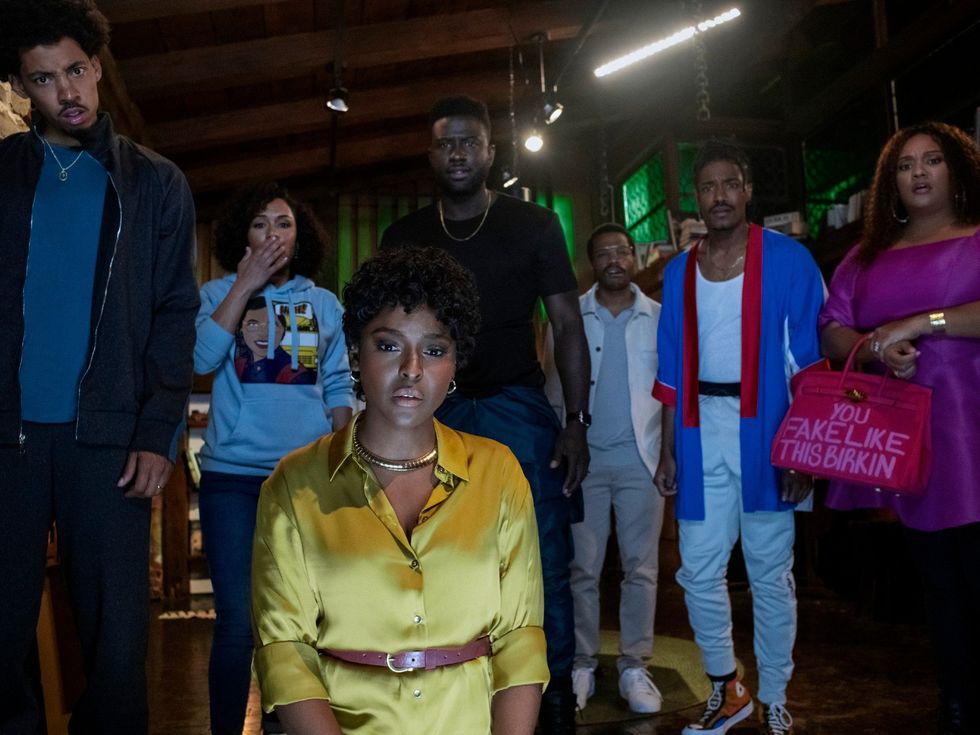Movie Review
The Blackening takes on horror movie clichés and racism in one fell swoop
Horror movie parodies typically play pretty well because as much fans love to be scared by horrors, they also love to laugh at the genre’s clichés and stereotypes. The Scream franchise has been successful straddling the line between actual horror and parody, and the Wayans Brothers made almost $900 million collectively with the five movies in the Scary Movie franchise.
The Blackeningtakes things one step further, making the often-implicit racism in horror movies explicit. A group of Black friends – Lisa (Antoinette Robertson), Dewayne (Dewayne Perkins), Nnamdi (Sinqua Walls), Allison (Grace Byers), Shanika (X Mayo), King (Melvin Gregg), and Clifton (Jermaine Fowler) – have gathered at a remote cabin as a kind of school reunion/Juneteenth celebration.
The friends soon discover a game room, where a board game called “The Blackening” is displayed prominently. Not knowing that two of their friends – Morgan (Yvonne Orji) and Shawn (Jay Pharoah) – had arrived previously and found the game, the group unwittingly starts to play, and quickly discover that the game is designed just for them, with questions designed to test their “Blackness” and penalties ranging from torture to death for anyone who gets them wrong.
Directed by Tim Story and written by Perkins and Tracy Oliver, the film trades on the long history of institutional racism, which is a fully accepted concept in the world of the film. The characters hardly blink when they’re confronted with racist imagery or by white people in authoritative positions. It’s all part and parcel of their day-to-day reality, and while still distressing to a degree, they don’t get too upset by it.
What is upsetting is the anonymous killer trying to knock them off one by one. The film leads with comedy – its tagline is the knowing “We Can’t All Die First” – although it aims to be smarter than the notoriously stupid Scary Movie films. The game’s questions range from light (“Name five black actors who were in Friends”) to more serious, but all involve the threat of death. People do get hurt in the various attack scenes, but they’re staged in almost a slapstick manner, a combination of tones that works more often than not.
After a promising beginning, however, the film gets bogged down in the second half. The filmmakers throw out a lot of clever ideas in the first act, but they seem to run out of steam as the story goes along. They never really commit to making the villain scary, so even though terror is not the first priority, that lack undercuts the story to a degree. The film does subvert one big horror movie trope toward the end, but in so doing, it limps toward an unsatisfactory conclusion instead of going out on a high.
The cast is comprised mostly of up-and-coming, lesser-known actors, and they play off each other extremely well. Most notable among the group are Perkins, who wrote himself a nice, plum part that he nevertheless kills; Byers, who gets a lot of funny lines that play on her comparatively light skin; and Walls, whose character always seems to be at the center of the action.
While The Blackening isn’t as successful as it could have been, it has way more positives than negatives going for it. A horror parody with an edge to it, it serves as both a sending-up of the genre and a reckoning for the long history of discrimination Black people have faced in such films.
---
The Blackening is now playing in theaters.




 Crystal Charity Ball 2024 chairman Cheryl Joyner and Richard Joyner.
Photo by Ashley Gongora
Crystal Charity Ball 2024 chairman Cheryl Joyner and Richard Joyner.
Photo by Ashley Gongora